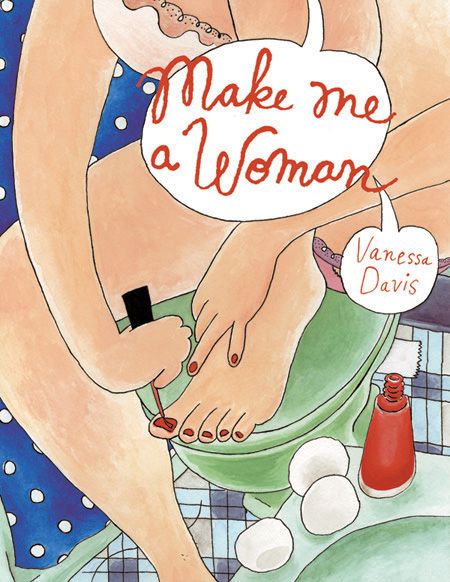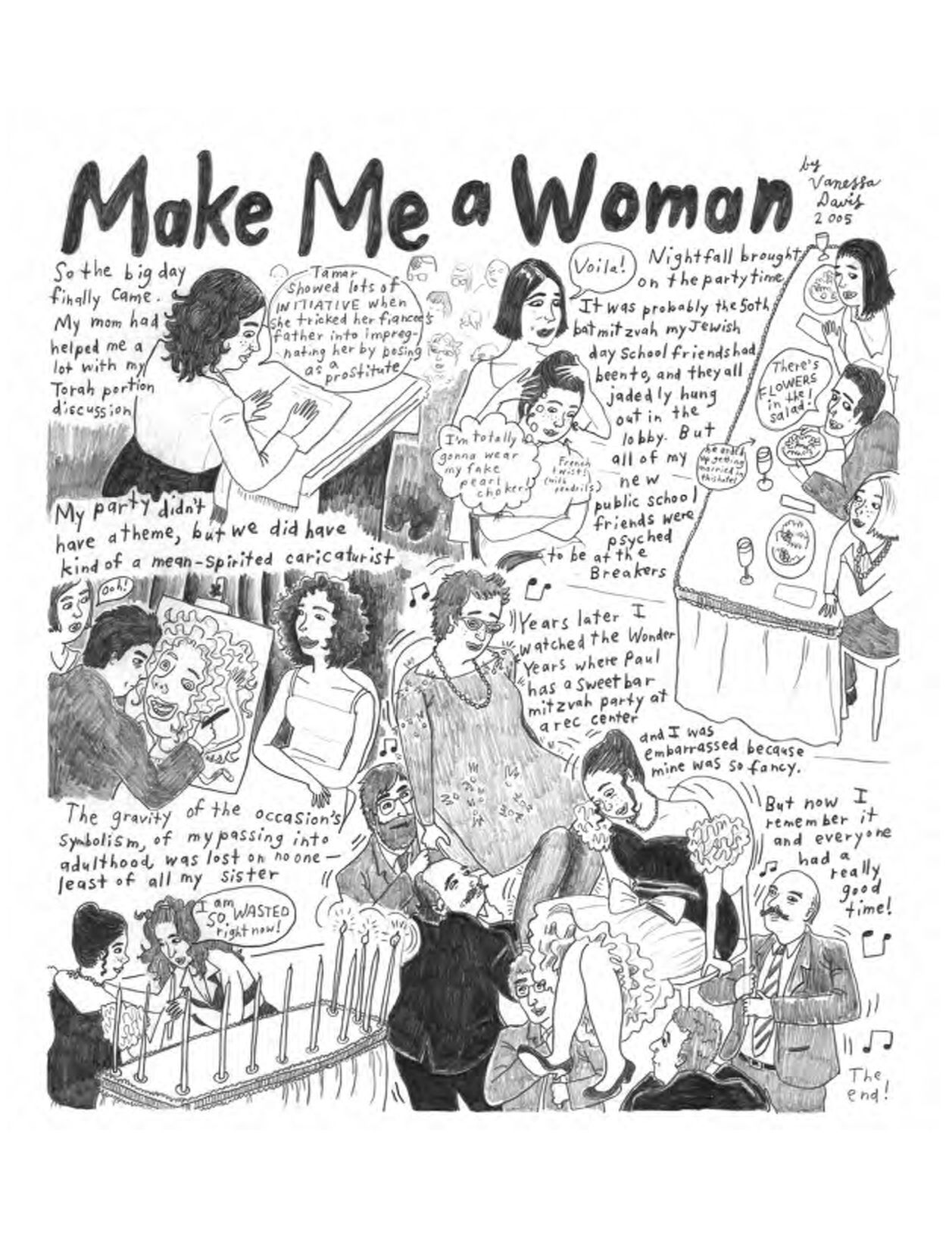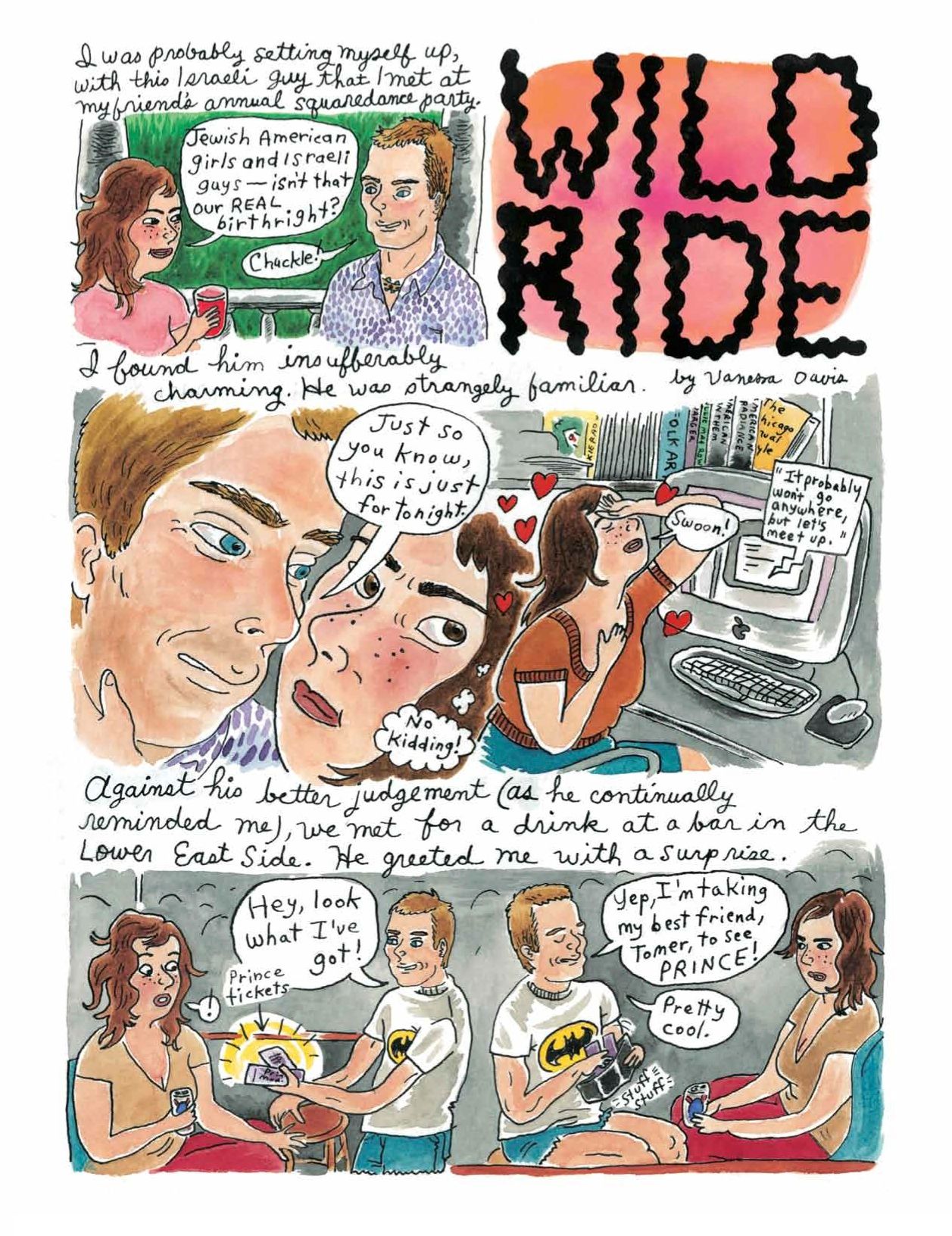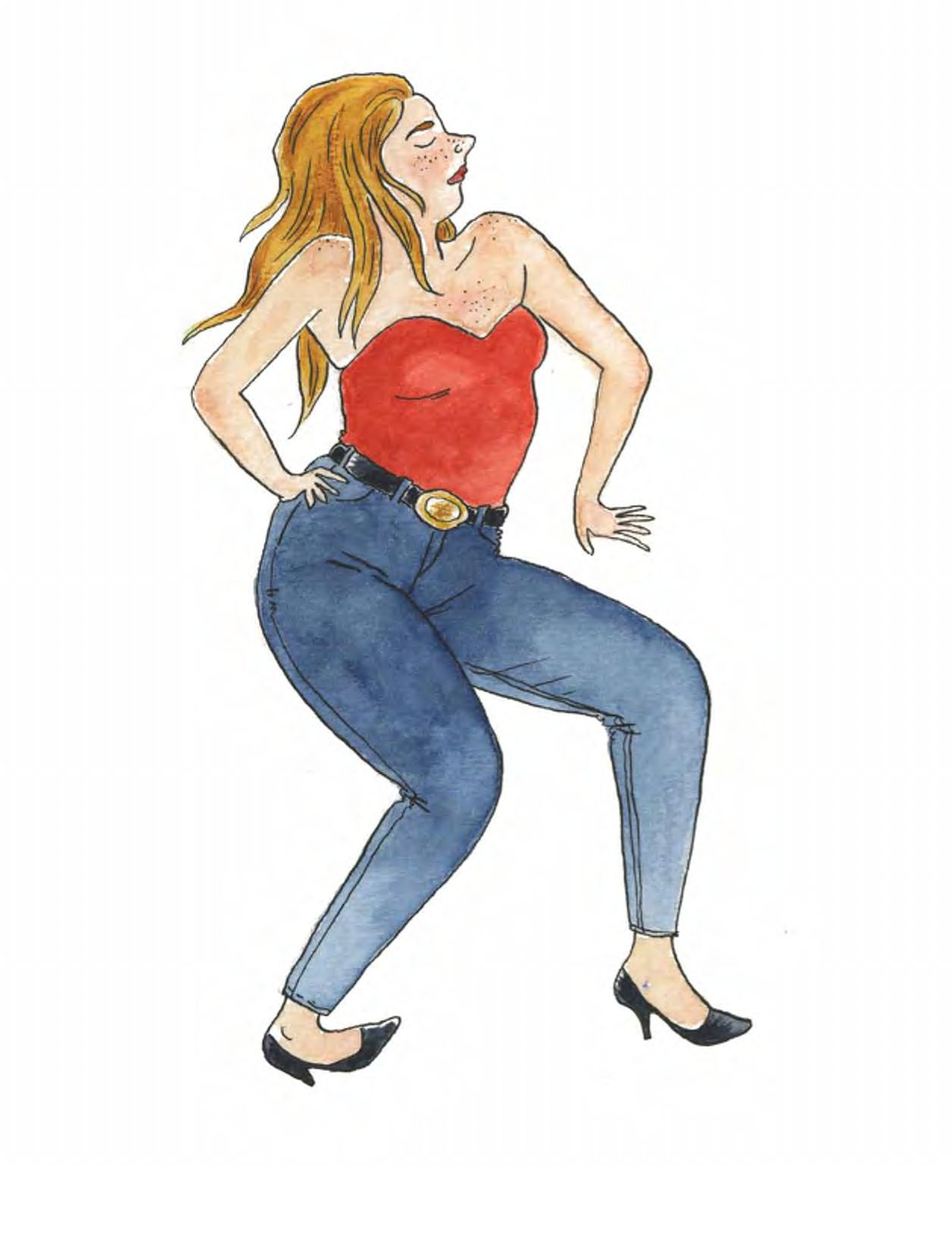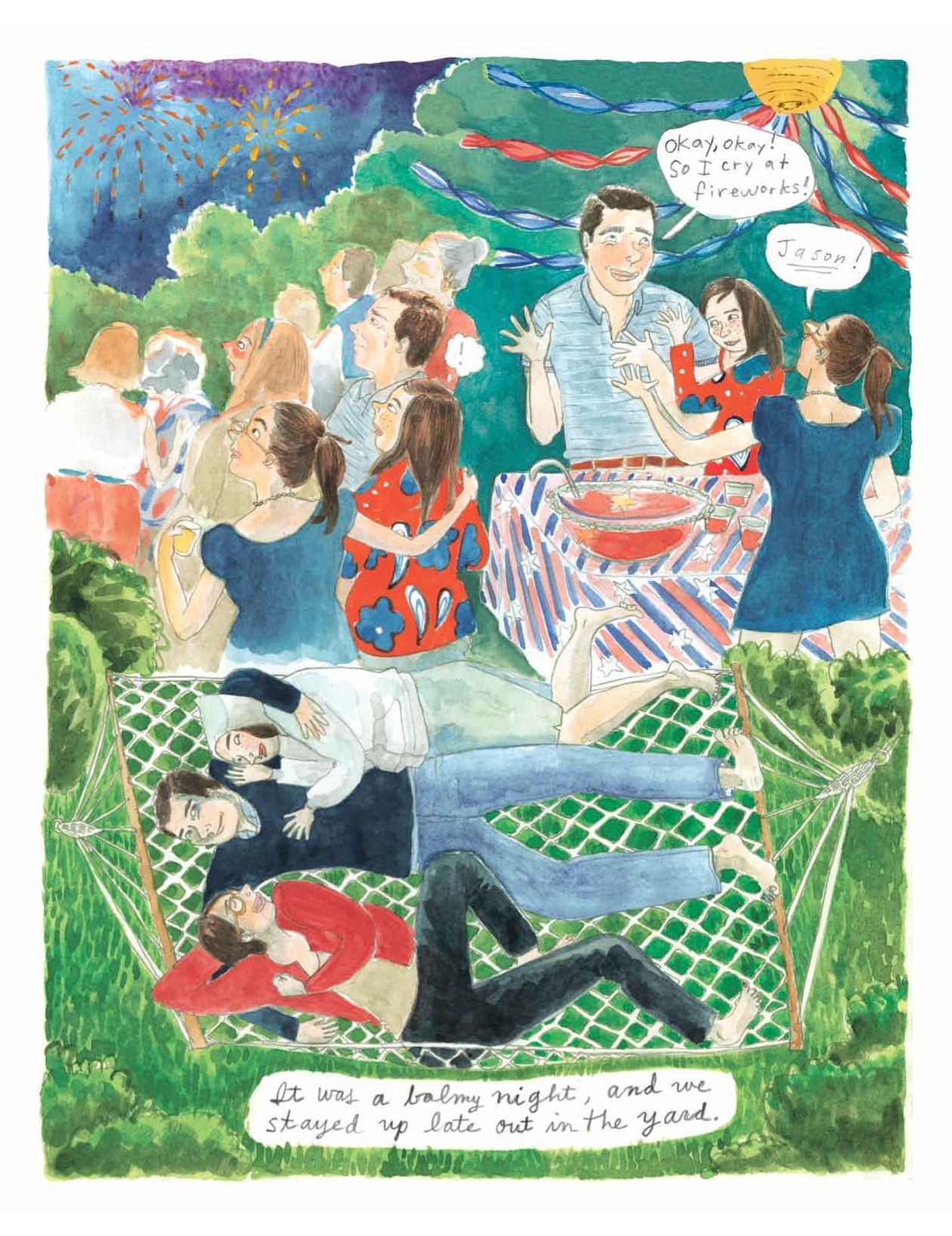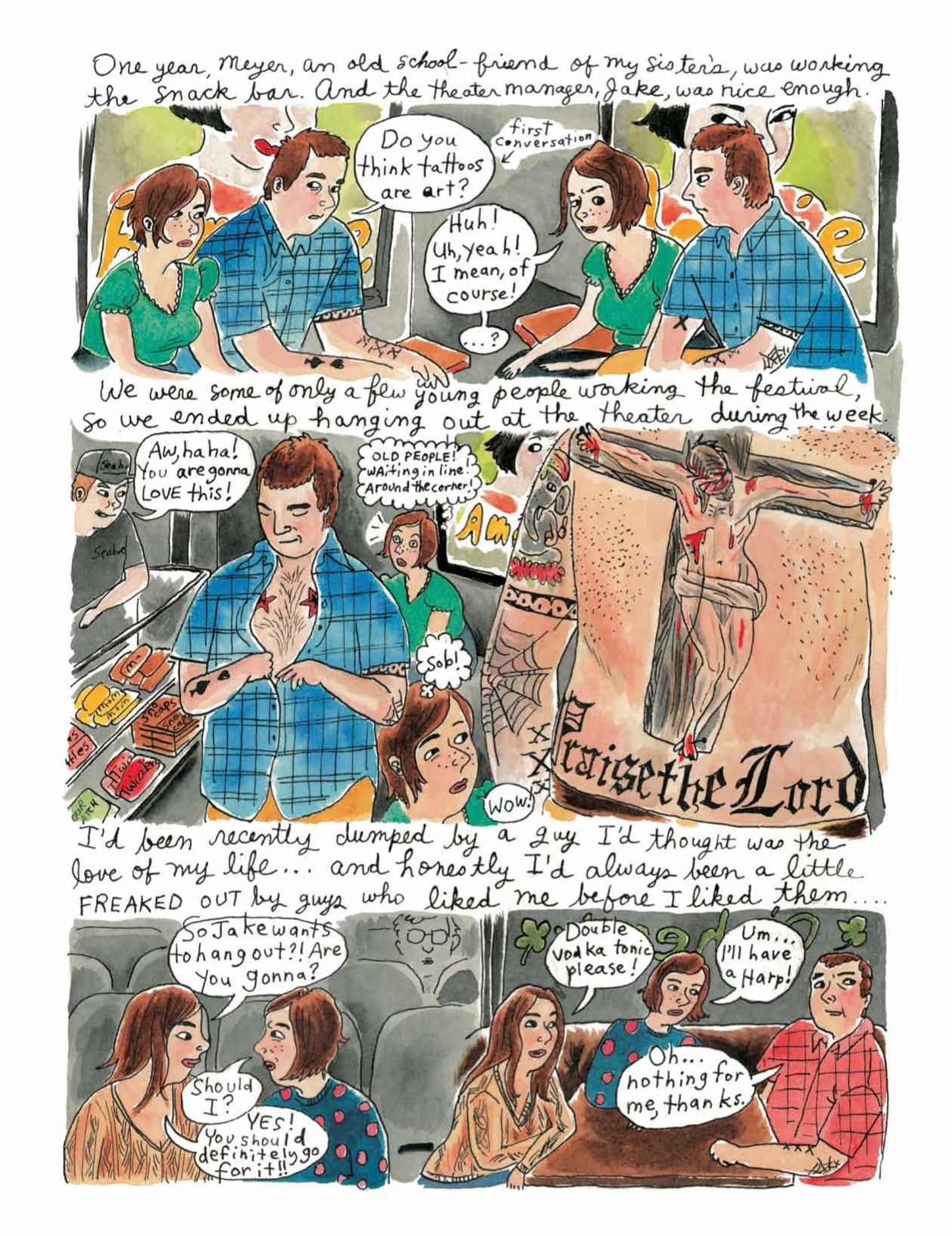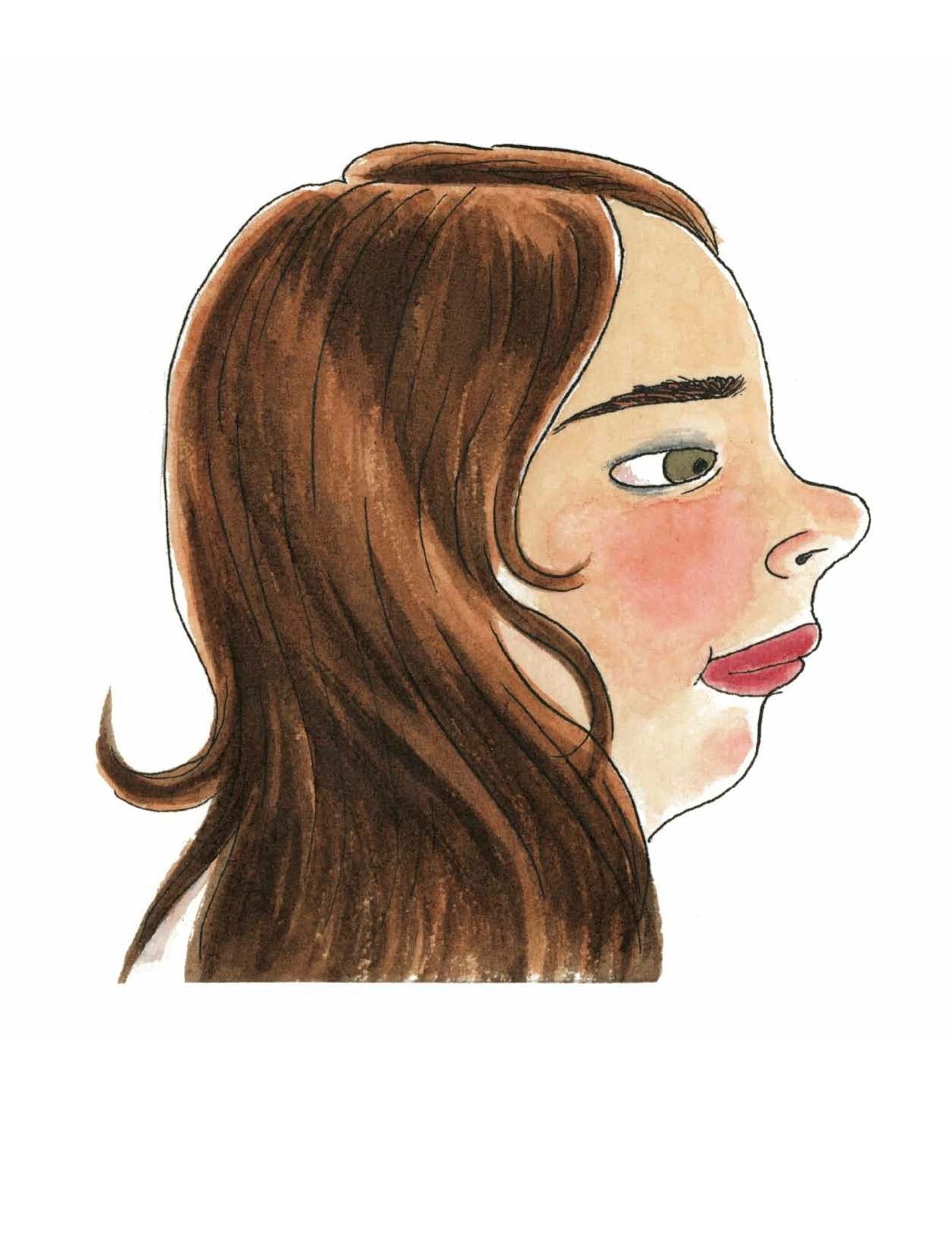One of the more notable indie books debuting at the San Diego show this week is Vanessa Davis' latest book, Make Me A Woman, published by Drawn & Quarterly.
Ever since she made made her debut in anthologies like True Porn and Kramer's Ergot, Davis' work has exuded a warmth, humor, and sense of style that few of her compatriots can match, a fact only underscored by her 2005 book, Spaniel Rage, published by the late, lamented Buenaventura Press.
It's been far too long since we've had a new book from her, but Make Me A Woman is thankfully worth the wait. Lest the title fool you into thinking the book is some saucy romp, let me be quick to dash some cold water on your overheated imagination. Mostly containing stories originally serialized in Tablet magazine, as well as some sketchbook strips and other material, the book explores how her relationship towards her family, friends, religion and self-image has changed as she's matured. Along the way she talks about her experiences at fat camp, her feelings towards Robert Crumb's Genesis adaptation and why she'd still like a present for Hanukkah.
I chatted with Davis over email last week about her new book and how she broke into comics. It was a genuine pleasure and I hope I don't have to wait another five years for the opportunity to talk about her work with her again.
First of all, I was wondering if you could give me a bit of a truncated biography. I realized I don't know much about your background beyond the work that's appeared in Spaniel Rage and your new book. When were you first introduced to comics? What were your primary influences? And what made you want to be a cartoonist?
As a kid I read Archie, and my mom actually tried to get me into comics more seriously as I got older, but we went to a normal comics shop when I was about 11, and really couldn't find anything I wanted to read. I got one issue of Amethyst because I liked gems, but abandoned it after that. I liked Archie because of the everyday teenage drama, and I loved the vintage styles of the older illustrations, and the clothes.
I went to an arts middle- and high school in South Florida, where I grew up, and they really dissuaded kids from normal youth-directed forms of art, so I forgot about comics and illustration and focused a lot more on worldly painters, fashionable bohemians, and feminist sculptors when I was a teen. I still loved artists with a more narrative/figurative bent, though, like Alice Neel, David Hockney, and Ana Mendieta.
I think my parents are big influences, too: my dad was a funny photojournalist and my mom a writer; both of them with a major curiosity about the world and a passion for observing people and places. I learned about comics way before I ever thought I would ever want to make any, though. I got into Julie Doucet from Sassy magazine, and found a few of her comics at a local record store, and my aunt sent me a copy of Twisted Sisters 2 that I pored over obsessively for years. And my mom got this huge, comprehensive book of Charlotte Salomon paintings, which made a big impact on me as a teenage girl: they were so free-flowing and diaristic and documentary.
In college I learned about Harvey Pekar, and then about Dan Clowes and Chris Ware and the Highwater cartoonists, which was exciting. I still thought I was a painter at the time, though I was doing autobio paintings and drawings. I thought I shouldn't write -- that the strength of my artwork was in its "mystery." It wasn't until I moved to NY in my 20s where I had no room to paint, and had internet for the first time and could see more comics going on, that I thought I'd give it a try. And then I got sucked in!
I wanted to ask you about your art style. Thought it's gotten a bit looser and more relaxed it hasn't changed that much from when I first encountered your work (which was either in Kramer's or another anthology). That struck me as interesting since usually you see an artist's line change dramatically from their early work on up. Your comics seem to have sprung from the ground fully formed, which I'm sure isn't the case. How conscious are you of your art style and developing it over time? What informs it? Where were you first published? How did you get from deciding to make comics to appearing in Kramer's and getting your first book, Spaniel Rage?
Oh, I definitely don't think my comics have sprung from the ground fully formed! Wouldn't that be nice! I think that I did begin doing comics with and maintain a particular style that was how I naturally drew, for the most part, after many years of drawing and art school. I started drawing comics relatively late, compared to people who've deliberately been in a comics frame of mind -- in my early 20s. So hopefully I've still got a lot of comics development to do!
I'd struggled with drawing, and often got criticism in school for having such an illustrative, "flat" style, since to draw well, you're supposed to be open and looking, not have a style at all. It was hard because all of my favorite artists had this emphasis on flatness, line, and pattern. It changed in college, somewhat arbitrarily in my opinion, but all of a sudden my teachers were telling me how I was good at drawing -- that I was finally processing my ability to draw into a confident, symbolic type of line; that my lazy approach towards perspective was actually "defiant." I was dubious but also relieved!
Anyways I've always kept a sketchbook, and my personal drawings were always a mix of cartoony and trying to draw in earnest. When I decided to start drawing comics, it was a challenge to know how to do it. It seemed like real cartoonists were much more polished, had a visual language that flowed out of them like speech. So for me, I felt like I needed to tighten up and get to that point. I was overwhelmed by not knowing how to start, or what I wanted my comics to look like, so I decided to keep a sketchbook diary, where I could teach myself these things as I went along, make those decisions as they came up. I still keep one, especially when I feel disconnected from comics, either after a period of writers' block or laziness or whatever.
Now as I've become more experienced, taken on different challenges, and I've also been exposed to a TON more comics, I think I can't help but make changes and be influenced by others' work. You see things that other cartoonists do that you like or you don't like, seems like it might work for you, etc. I'd always worked in pencil, but I'd never had the means to publish in color. So for Kramers I inked and colored, and I liked it so much, I did comics that way much more often. I always liked avoiding panels, because I wanted to be open to filling up space with as much visual information as seemed necessary. When I started doing some more commercial work, for Tablet, and I needed to be a bit more concise and direct (and fast), panels finally became just what I needed. I tried to adapt that way, and be purposeful. I drew the story about this guy I dated, and he had a pretty distinctive upper lip, so the way I'd shorthandedly drawn guys didn't work. I had to draw it different, and I realized it looked much better. So I figure out what can be cartoonified and what should be represented as I go.
I decided to draw comics for real when I turned 23. It was my birthday and after eating Thai food with my friend I went home and started drawing scenes from a comic that eventually ended up in my story "Framed!?" that I did last year for Tablet. That never went anywhere but then another friend was telling me about a makeout session gone awry, and I thought it'd be a great story to try to turn into a comic, since all of my own stories seemed really overwhelming, I didn't know how to start. So I used hers. Then I saw the call for entries to that anthology True Porn, online. So I submitted my story for fun. It got in, and through that project I met Robyn Chapman, who had just moved to New York, and she introduced me to a lot of cartoonists who eventually became good friends and we'd get together weekly to draw. I remember first hanging out with Robyn and being like, "So what ink do I need?" Stuff like that. I learned a lot from meeting other cartoonists and seeing their work. I began doing my sketchbook comics, and made my first Spaniel Rage mini to hand out at MoCCA. I gave one to Sammy Harkham and he liked it. Then at another show Sammy showed my work to Alvin Buenaventura's wife, who liked it. So a little time went by and I kept making my minis and doing a few other things here and there, and first the book happened, and then Kramers.
One of the things I noticed about your art style is that you avoid gutters and often just let the images flow one into the next without any panel borders at all. Is that a conscious decision and if so, how did it come about?
I avoided panels and gutters from the beginning as part of my diary format. That's also why I didn't ink -- I just wanted to be spontaneous, I wanted to feel out the process or something. Also, I found panels intimidating, as I had to pre-plan things too much to structure the comic that way. And I liked how the open space left room for details, and improvisational visual connections. I wanted to have as much page space as possible.
Since working on the Tablet strips, which DID need to be pre-planned and organized, and clear and coherent, most of all, I started using them more. I had to do one page with a lot of individual incidents shown, and coming up with whimsical, amorphous visual borders seemed schticky and arbitrary, so I gridded out the page. I really liked how the panels looked and I liked how my writing adapted to using them. So now I've been using panels more often.
I also wanted to ask you about your interest in autobiography, which makes up the bulk of both your new book and Spaniel Rage. What is it about this genre that appeals to you?
It's something that has just always come naturally for me, it was there for me even before I started drawing comics. I always kept a sketchbook diary, so my drawing subject matter was always linked to what was going on in my life. If something exciting happened to me, I'd draw it in my sketchbook, etc. I think, too, that much of what I connected to while in art school, about making art, was inextricably linked with autobiography. I had one painting teacher who painted one painting a day every day, as a diary entry, and when I saw the hundreds of paintings up in his studio that were this documentation of several years of his life, I was extremely affected. I think, also, since my parents were journalists, their own lives were so interesting, as their work took them to lots of cool places and into weird situations, and then of course, the people they were writing about/photographing. It just has always been there, the focus on experiences, it's always fascinated me. The autobio comics I read as I got into comics inspired me to start working in comic form, I'm sure. Those were always my favorite ones to read.
Your new book, Make Me A Woman, includes a lot of stories you did for Tablet magazine. How did that relationship come about? Did you have a specific goal in mind with those stories (ie. exploring your Jewish heritage) or did they flow out more or less organically?
I started working for Tablet doing spot illustrations. Then a few years ago, they had a concept for a punky, feminist comics version of the story of Purim, and suggested I put it together. They liked how it came out, and we discussed having a more regular comics feature. Since I normally do autobio, we decided it might be cool for me to explore Jewish and not-so-Jewish themes in my life. I grew up in a Jewish community, attended Jewish day school, and have pretty much taken Jewishness as a given for most of my life. As I get older and move different places, I've found that my relationship to Judaism changes.
The book's title, obviously, not only refers specifically to one of the stories, but also the the book's general theme of self-discovery and maturation. Was this a conscious effort on your part or was it something you realized about the collection after the fact?
No, I hadn't imagined using "Make Me a Woman" as the entire book's title until way after the fact. When I titled my bat mitzvah-themed strip, it just popped into my head and seemed funny and strange and maybe a little daring. I definitely didn't plan on the book's theme being self-discovery and maturation. I think because of the nature of the autobiographical content and where I am in my life, it just naturally reflected that.
Most of your work to this point has been short stories. Are you interested in attempting something longer or are you more or less happy with working with a shorter page count?
I like doing short stories. My whole life, I've been encouraged to "keep it brief." I am finding the short comic form to be just right for me, at least right now.


